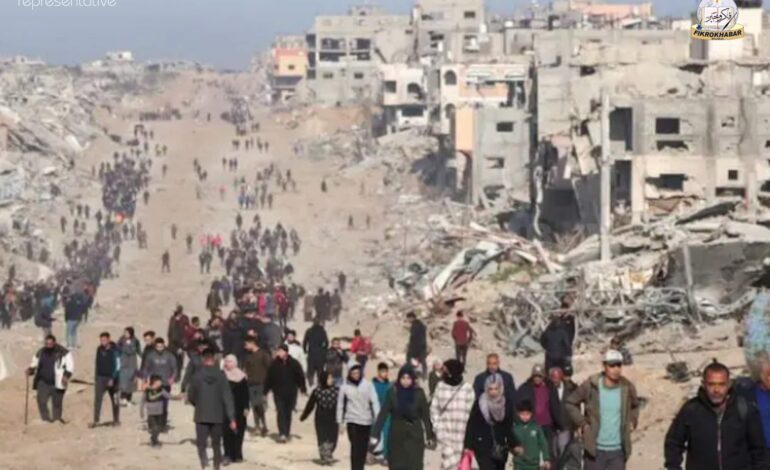Gaza Peace Plan: A Step Towards Peace or a New Form of Occupation?

By Masood Abdali
HOUSTON (United States): U.S. President Donald Trump on September 29 has announced a 21-point peace plan for Gaza, which is being presented as a solution to end the ongoing war in Gaza and to turn the region into an area “free from extremism and terrorism.” The key points of the plan have been published by Israeli Hebrew media, and are as follows:
- Gaza Strip will be declared a demilitarized zone to ensure there are no security threats to Israel.
- If the resistance groups accept the plan, all military operations will be suspended, and Israeli forces will gradually withdraw.
- All living Israeli hostages and injured persons must be released within 72 hours.
- In return, Israel will release 250 Palestinian prisoners sentenced to life imprisonment and an additional 1,700 detainees from Gaza, including women and children.
- For every Israeli hostage’s remains, the remains of 15 Gazan residents will be returned.
- Resistance members who surrender their weapons and agree to peaceful coexistence will be granted a general amnesty.
- Those wishing to leave Gaza will be provided with safe passage.
- Immediate humanitarian aid will be sent to Gaza, along with efforts to restore infrastructure, rebuild hospitals, bakeries, and clear debris.
- The entry and distribution of aid will be monitored by the United Nations and other international organizations. The Rafah crossing will be opened in both directions.
- Control of Gaza will be handed over to a Palestinian technocratic committee, which will be overseen by a newly formed “Peace Council” chaired by President Trump.
- This committee will manage public services and look after the interests of Gaza’s residents.
- special economic zone will be established, creating investment and employment opportunities.
- Gaza residents will be free to choose between staying or emigrating.
Although this plan is presented under the banner of peace, its spirit and structure suggest it is primarily designed to safeguard Israeli interests.
One of the most critical points is that the actual parties to the conflict—the resistance groups—have not even been invited to the negotiations. This is akin to deciding a court case without hearing from either the plaintiff or the defendant. If the key stakeholders are not taken into confidence, how can the agreement be sustainable or effective? Any plan formulated without the involvement of elected Palestinian leadership and public participation is merely an administrative arrangement—not a genuine step towards lasting peace.
The mediator of this plan, the United States, is in practice the biggest supporter and enabler of Israel. Therefore, it is nearly impossible for the resistance groups to trust its neutrality. Although Qatar and Egypt have represented the resistance groups to some extent, both countries have formally labeled these groups as “terrorists”, making their representation seem purely symbolic.
The core objective of the plan appears to be to disarm the resistance and remove them from the affairs of Gaza, while simultaneously legitimizing a permanent Israeli buffer zone. The interim arrangement, to be led by President Trump, along with an indicated major role for former UK Prime Minister Tony Blair, further highlights the problematic nature of this initiative—especially given Blair’s controversial and suspect role in Iraq.
During the announcement, President Trump placed full blame for the bloodshed on the resistance, while justifying and even praising Israel’s aggression. He referred to Israel’s 2005 withdrawal as “leaving a beautiful land for the sake of peace,” whereas in reality, Israel evacuated an occupied territory under pressure from Palestinian resistance, in accordance with the Disengagement Law passed by the Israeli parliament. Trump extensively highlighted the sacrifices of Israeli prisoners, but made no mention of the thousands of Palestinian martyrs, exposing the one-sided nature of this plan.
So what direction will the region take after this agreement? It appears that there are plans to transform Gaza into an international tourist and recreational destination, to be built with funding and security support from the Arab and Islamic world.
Will the resistance groups accept this plan?
At the time of writing, even the draft of the plan has not been shared with them. If they reject it, there is a strong possibility of a new round of conflict in the region, with global implications. President Trump has made it clear that if the resistance rejects the agreement, Israel will have full U.S. support to crush them.
When two years of relentless bombing failed to eliminate the resistance, how can a mere written agreement succeed in achieving “de-radicalization”?
Given the tone of Trump’s speech, the arrogance of Netanyahu, and the entire presentation of the plan, this appears to be less about peace and more about imposing a new form of pressure and permanent occupation on Gaza.
The real question remains: Can peace ever be achieved through force?
Interestingly, without any reflection or mutual consultation, the foreign ministers of Saudi Arabia, Jordan, the UAE, Indonesia, Pakistan, Turkey, Qatar, and Egypt immediately issued a joint statement welcoming President Trump’s “sincere efforts” and expressing their willingness to cooperate—and even partner—with the U.S. in bringing peace to the region.
Their reaction can best be described by the Urdu idiom: ‘Begaane ki shaadi mein Abdullah deewana’ — an idiom referring to someone irrationally enthusiastic about a matter that doesn’t concern them.
Source: India Tomorrow



